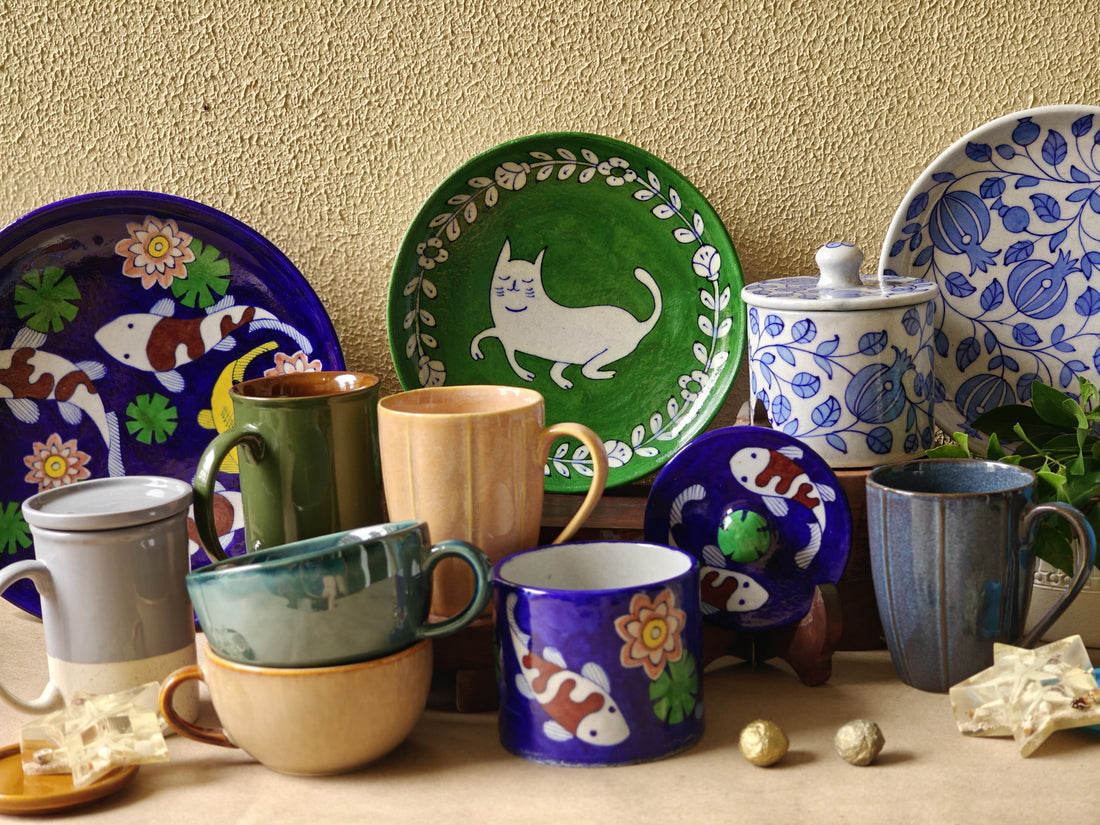
My tryst with Blue Pottery
As I continue to reminisce about the past and revisit some cherished childhood moments, I find myself thinking about the first handicraft that became a part of my life—Blue Pottery. Growing up in northern India in the '90s meant that summers were spent at Nani’s house or in the hills, while winters were often a trip back to Nani's or to Rajasthan. Jaipur, the Pink City, has long been known for its rich cultural heritage—its food, juttis (traditional camel leather shoes), tie-dye clothes, block prints, wooden furniture, and, of course, blue pottery.
I believe it was my paternal grandfather who first introduced us to this exquisite craft. His collection included a stunning ashtray, a couple of candle stands, a delicate surahi (water jug), and coasters, each piece a testament to the artistry of Blue Pottery. From that moment on, every trip to Rajasthan was marked by a hunt for a new blue pottery piece to bring home. Over the years, my mother has turned her collection into functional pieces to give it a new avtaar—a blue pottery vase converted into a lamp, a bird feeder transformed into a plant holder, a blue pottery mug now serving as a vase, and a planter that still holds pride of place in our home. The list goes on.
Growing up with blue pottery in various forms around my house, it never crossed my mind that not everyone would be familiar with this craft. However, as I began talking to people and connecting with others who shared a passion for arts and crafts, I realized that India is home to a vast array of handicrafts, many of which remain unknown to many. My fascination with these crafts grew even deeper, and I began to imagine what it would be like to have a piece of each one in our homes. Our spaces would then be filled with not only beautiful art but also our rich heritage, history, and love. This is why blue pottery holds a special place in my heart and feels like a foundational element of Chokar.
Jaipur Blue Pottery, introduced by the Mughals, traces its origins to Chinese glazing techniques and Persian artistry. Its name comes from the use of cobalt blue in the early days of the craft. Handcrafted by artisans, often in their homes which serve as workshops, this vibrant pottery flourished in Jaipur under the patronage of Maharaja Sawai Man Singh II but faced a decline before being revived in the mid-20th century by ceramist Kripal Singh Shekhawat. One of the master artists we work with is a third-generation potter, whose father—his teacher—was a student of Shekhawat himself.
Kripal Singh Shekhawat introduced new designs and colors, ensuring the craft’s continued relevance and prosperity. The craft has since evolved, with artists embracing experimentation and new designs. Renowned for its use of materials like fuller's earth (multani mitti), powdered glass, and gum, Jaipur Blue Pottery is characterized by its intricate patterns inspired by nature, interlaced weaves, and motifs drawn from Islamic and Mughal art.
Our first bulk, overseas, and customized order in the very first month of our launch came from a wonderful couple who wanted their wedding to celebrate their rich, diverse heritages—Indian and Persian—and reflect their love for tea. A Jaipur Blue Pottery jar was the perfect choice: a versatile piece that could store tea, sugar cubes, cookies, and even memories, crafted with a traditional bel design in traditional blue colour.
At Chokar, our vision for Blue Pottery is to create a range of beautiful, functional products that blend contemporary aesthetics with traditional techniques. We aim to celebrate the craft while ensuring it thrives, giving artists the recognition they truly deserve.
Do check out the website for Chokar Exclusives. This is just beginning of our journey toward realizing our vision, but we need your support to make it happen. Please read, share with your friends and family, and consider buying from us to make Chokar a part of your lives. We’re also happy to discuss bulk orders, customizations, and collaborating on designs.
